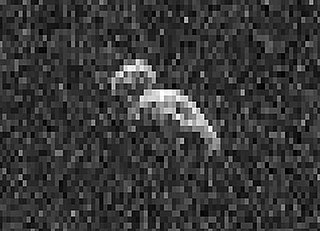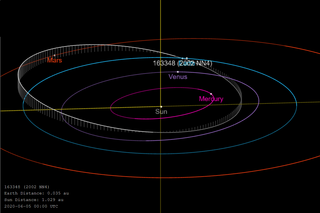Related Research Articles
(12538) 1998 OH is a stony asteroid, classified as near-Earth object and potentially hazardous asteroid of the Apollo group, approximately 1.8 kilometers in diameter. It was discovered on 19 July 1998, by astronomers of the Near-Earth Asteroid Tracking program at the Haleakala Observatory in Hawaii, United States. In 2019, the asteroid came within about 73 lunar distances of Earth.

(480808) 1994 XL1 is a sub-kilometer asteroid, classified as near-Earth object and potentially hazardous asteroid of the Aten group, approximately 200 meters (700 feet) in diameter. It was discovered on 6 December 1994, by Scottish–Australian astronomer Robert McNaught at Siding Spring Observatory in Australia. It was one of the first asteroids discovered to have a semi-major axis less than Venus.
4401 Aditi, provisional designation 1985 TB, is an eccentric, stony asteroid, classified as a near-Earth object and Amor asteroid, approximately 1.8 kilometers in diameter. It was discovered on 14 October 1985 by American astronomer Carolyn Shoemaker at Palomar Observatory in California, and later named after the Hindu goddess Aditi.

(7482) 1994 PC1 is a stony asteroid, classified as near-Earth object and potentially hazardous asteroid of the Apollo group, approximately 1.1 kilometers in diameter. It was discovered on 9 August 1994, by astronomer Robert McNaught at the Siding Spring Observatory in Coonabarabran, Australia. With an observation arc of 47 years it has a very well known orbit and was observed by Goldstone radar in January 1997. The 2022 approach has been observed every month since August 2021.
(242450) 2004 QY2 (prov. designation:2004 QY2) is an asteroid on an eccentric orbit, classified as near-Earth object and potentially hazardous asteroid of the Apollo group, approximately 3 kilometers (2 miles) in diameter. It was discovered on 20 August 2004 by the Siding Spring Survey at an apparent magnitude of 16.5 using the 0.5-metre (20 in) Uppsala Southern Schmidt Telescope. It is one of the largest potentially hazardous asteroids known to exist.

(388188) 2006 DP14, provisional designation 2006 DP14, is a sub-kilometer sized, peanut-shaped asteroid on a highly eccentric orbit, classified as near-Earth object and potentially hazardous asteroid of the Apollo group. This contact binary was discovered on 23 February 2006, by astronomers of the LINEAR program at the Lincoln Laboratory's Experimental Test Site near Socorro, New Mexico, in the United States. On 10 February 2014, it passed 6.25 lunar distances from Earth. The asteroid is approximately 400 meters in diameter and has a rotation period of 5.77 hours.
(391211) 2006 HZ51 is a bright, sub-kilometer asteroid on an eccentric orbit, classified as a near-Earth object and a potentially hazardous asteroid of the Amor group. It was discovered on 27 April 2006, by astronomers of the Catalina Sky Survey conducted at Mount Lemmon Observatory, Arizona, United States. During preliminary observations, it was thought to have a small chance of impacting Earth in 2008. The asteroid measures approximately half a kilometer in diameter and has an exceptionally high albedo.
(89830) 2002 CE, is a stony asteroid, classified as near-Earth object and potentially hazardous asteroid of the Amor group, approximately 3.1 kilometers in diameter. It was discovered on 1 February 2002, by astronomers of the LINEAR program at Lincoln Laboratory's Experimental Test Site near Socorro, New Mexico, in the United States. This asteroid is one of the largest potentially hazardous asteroid known to exist.
(90075) 2002 VU94 (provisional designation 2002 VU94) is an asteroid on an eccentric orbit, classified as near-Earth object and potentially hazardous asteroid of the Apollo group, approximately 2.5 kilometers in diameter. It was discovered on 13 November 2002, by astronomers of the Near-Earth Asteroid Tracking program at Palomar Observatory in California, United States. It is one of the largest potentially hazardous asteroids known.
(159857) 2004 LJ1, provisional designation 2004 LJ1, is an asteroid on an eccentric orbit, classified as near-Earth object and potentially hazardous asteroid of the Apollo group, approximately 3 kilometers in diameter. The asteroid was discovered on 10 June 2004, by astronomers of the LINEAR program at Lincoln Laboratory's Experimental Test Site near Socorro, New Mexico, in the United States. It is one of the largest potentially hazardous asteroids known to exist.
(85713) 1998 SS49 (provisional designation 1998 SS49) is an asteroid on an eccentric orbit, classified as near-Earth object and potentially hazardous asteroid of the Apollo group, approximately 3 kilometers (1.9 miles) in diameter. The asteroid was discovered on 29 September 1998, by astronomers of the LINEAR program at Lincoln Laboratory's Experimental Test Site near Socorro, New Mexico, in the United States. It is one of the largest potentially hazardous asteroids and has a notably low Earth-MOID of less than the distance to the Moon.

(52768) 1998 OR2 (provisional designation 1998 OR2) is an asteroid on an eccentric orbit, classified as a near-Earth object and potentially hazardous asteroid of the Amor group, with a diameter of 2 kilometers (1.2 mi). It was discovered on 24 July 1998, by astronomers of the Near-Earth Asteroid Tracking (NEAT) program at the Haleakala Observatory, Hawaii. It is one of the brightest and therefore largest potentially hazardous asteroids known to exist. With an observation arc of 35 years, the asteroid has a well-determined orbit, and its trajectory is well known through the year 2197. The asteroid's orbit is only potentially hazardous on a time scale of thousands of years.
2013 GM3 is a micro-asteroid, classified as near-Earth object of the Aten group, approximately 20 meters in diameter. It was first observed on 3 April 2013, by astronomers of the Mount Lemmon Survey conducted at the Mount Lemmon Observatory near Tucson, Arizona, United States.

(505657) 2014 SR339, provisional designation 2014 SR339, is a dark and elongated asteroid, classified as near-Earth object and potentially hazardous asteroid of the Apollo group, approximately 970 meters (3,200 feet) in diameter. It was discovered on 30 September 2014, by NASA's Wide-field Infrared Survey Explorer telescope (WISE) in Earth's orbit. Closely observed at Goldstone and Arecibo in February 2018, it has a rotation period of 8.7 hours.
(163243) 2002 FB3, provisional designation 2002 FB3, is a stony asteroid on an eccentric orbit, classified as near-Earth object and potentially hazardous asteroid of the Athen group, approximately 1.6 kilometers (1 mile) in diameter. It was discovered on 18 March 2002, by astronomers with the Lincoln Near-Earth Asteroid Research at the Lincoln Laboratory's Experimental Test Site near Socorro, New Mexico, in the United States. The Q-type asteroid has a rotation period of 6.2 hours.

(164121) 2003 YT1, provisional designation 2003 YT1, is a bright asteroid and synchronous binary system on a highly eccentric orbit, classified as near-Earth object and potentially hazardous asteroid of the Apollo group, approximately 2 kilometers (1.2 miles) in diameter. It was discovered on 18 December 2003, by astronomers with the Catalina Sky Survey at the Catalina Station near Tucson, Arizona, in the United States. The V-type asteroid has a short rotation period of 2.3 hours. Its 210-meter sized minor-planet moon was discovered at Arecibo Observatory in May 2004.
(85182) 1991 AQ is a stony asteroid on a highly eccentric orbit, classified as near-Earth object and potentially hazardous asteroid of the Apollo group, approximately 1.1 kilometers in diameter. It was discovered on 14 January 1991, by American astronomer Eleanor Helin at the Palomar Observatory in California. Based on its brightness variation of 0.69 magnitude, this Q-type asteroid is likely elongated. It belongs to the small group of potentially hazardous asteroids larger than one kilometer.
(385343) 2002 LV, provisional designation 2002 LV, is a stony asteroid on a highly eccentric orbit, classified as near-Earth object and potentially hazardous asteroid of the Apollo group, approximately 1.5 kilometers in diameter. It was discovered on 1 June 2002, by astronomers with the Lincoln Near-Earth Asteroid Research at the Lincoln Laboratory's Experimental Test Site near Socorro, New Mexico, in the United States. The Sr-type asteroid has a rotation period of 6.2 hours and is likely elongated.
(154276) 2002 SY50, provisional designation 2002 SY50, is a stony asteroid on a highly eccentric orbit, classified as near-Earth object and potentially hazardous asteroid of the Apollo group, approximately 1.1 kilometers (0.7 miles) in diameter. It was discovered on 30 September 2002, by astronomers with the Lincoln Near-Earth Asteroid Research at the Lincoln Laboratory's Experimental Test Site near Socorro, New Mexico, in the United States. The K-type asteroid has a rotation period of 4.8 hours. It will make a close encounter with Earth on 30 October 2071.

(163348) 2002 NN4 (prov. designation:2002 NN4) is a dark, sub-kilometer near-Earth object and potentially hazardous asteroid of the Aten group that flew by Earth on 6 June 2020. The highly elongated X-type asteroid has a rotation period of 14.5 hours and measures approximately 0.7 kilometers (0.4 miles) in diameter. It was discovered by LINEAR at the Lincoln Laboratory's Experimental Test Site in New Mexico on 9 July 2002.
References
- 1 2 3 4 5 6 7 8 9 "JPL Small-Body Database Browser: 111253 (2001 XU10)" (2018-01-16 last obs.). Jet Propulsion Laboratory . Retrieved 19 January 2018.
- 1 2 3 4 "111253 (2001 XU10)". Minor Planet Center. Retrieved 19 January 2018.
- 1 2 3 Mainzer, A.; Grav, T.; Masiero, J.; Bauer, J.; Cutri, R. M.; McMillan, R. S.; et al. (November 2012). "Physical Parameters of Asteroids Estimated from the WISE 3-Band Data and NEOWISE Post-Cryogenic Survey". The Astrophysical Journal Letters. 760 (1): 6. arXiv: 1210.0502 . Bibcode:2012ApJ...760L..12M. doi:10.1088/2041-8205/760/1/L12.
- 1 2 "List of the Potentially Hazardous Asteroids (PHAs)". Minor Planet Center. Retrieved 19 January 2018.
- ↑ "LCDB Data for (111253)". Asteroid Lightcurve Database (LCDB). Retrieved 19 January 2018.
- ↑ "MPC/MPO/MPS Archive". Minor Planet Center. Retrieved 24 February 2018.